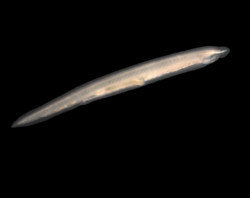Eumetazoa
| Eumetazoa Fossil range: Ediacaran - Recent |
||||||
|---|---|---|---|---|---|---|
 A lancelet
|
||||||
| Scientific classification | ||||||
|
||||||
| Phyla | ||||||
Radiata (unranked) Bilateria (unranked)
|
Eumetazoa is a clade comprising all major animal groups except sponges. Characteristics of eumetazoans include true tissues organized into germ layers, and an embryo that goes through a gastrula stage. The clade is usually held to contain at least Ctenophora, Cnidaria, and Bilateria. Whether mesozoans and placozoans belong is in dispute.
Some phylogenists have speculated the sponges and eumetazoans evolved separately from single-celled organisms, which would mean that the animal kingdom does not form a clade (a complete grouping of organisms descended from a common ancestor). However, genetic studies and some morphological characteristics, like the common presence of choanocytes, support a common origin.
Eumetazoans are a major group of animals in the Five Kingdoms classification of Lynn Margulis and K. V. Schwartz, comprising the Radiata and Bilateria - all animals except the sponges, placozoans and mesozoans.[1] When treated as a formal taxon Eumetazoa is typically ranked as a subkingdom. The name Metazoa has also been used to refer to this group, but more often refers to the Animalia as a whole. Many classification schemes do not include a subkingdom Eumetazoa.
Taxonomy
Over the last decade, the work of developmental biologists and molecular phylogeneticists spawned new ideas about bilaterian relationships resulting in a paradigm shift.
The current widely accepted hypothesis, based on molecular data (mostly 18S rRNA sequences), divides bilateria into the following four groups: Deuterostomia, Ecdysozoa, Lophotrochozoa, and Platyzoa (sometimes included in Lophotrochozoa). The last three groups are also collectively known as Protostomia.[2]
However, many skeptics emphasize the pitfalls and inconsistencies associated with the new data. Claus Nielsen, a professor of evolutionary invertebrate embryology at the Zoological Museum University of Copenhagen champions one of the most prominent alternative views based on morphological evidence. In his 2001 book Animal Evolution: Interrelationships of the Living Phyla, he maintains the traditional divisions of Protostomia and Deuterostomia.
Evolutionary origins
It has been suggested that one type of molecular clock and one approach to interpretation of the fossil record both place the evolutionary origins of eumetazoa in the Ediacaran.[3] However, the earliest eumetazoans may not have left a clear impact on the fossil record and other interpretations of molecular clocks suggest the possibility of an earlier origin.[4] The discoverers of Vernanimalcula describe it as the fossil of a bilateral triploblastic animal that appeared at the end of the Marinoan glaciation prior to the Ediacaran Period, implying an even earlier origin for eumetazoans.[5]
References
- ↑ Systema Naturae 2000 Taxon: Subkingdom Eumetazoa - retrieved February 22006
- ↑ Protostomia
- ↑ Peterson, Kevin J., and Nicholas J. Butterfield. "Origin of the Eumetazoa: Testing ecological predictions of molecular clocks against the Proterozoic fossil record." Proceedings of the National Academy of Sciences 102 (2005): 9547–9552. Full text online: doi:10.1073/pnas.0503660102.
- ↑ J. E. Blair and S. B. Hedges "Molecular clocks do not support the Cambrian explosion" Molecular biology and evolution 22 (2005): 387-390. PMID 15537810.
- ↑ Chen, J.-Y., Bottjer, D.J., Oliveri, P., Dornbos, S.Q., Gao, F., Ruffins, S., Chi, H., Li, C.-W. and Davidson, E.H. 2004. Small bilaterian fossils from 40 to 55 million years before the Cambrian. Science, 305 (2005): 218-222.
- Bilateria. Tree of Life web project, US National Science Foundation. 2002. 6 January 2006.
- Invertebrates and the Origin of Animal Diversity
- Evers, Christine A., Lisa Starr. Biology:Concepts and Applications. 6th ed. United States:Thomson, 2006. ISBN 0-534-46224-3.
- Metazoa: the Animals
- Nielsen, C. 2001. Animal Evolution: Interrelationships of the Living Phyla, 2nd edition, 563 pp. Oxford Univ. Press, Oxford. ISBN 0-19-850681-3
- Borchiellini, C. Manuel, M., Alivon, E., Boury-Esnault N., Vacelet, J., Le-Parco, Y. 2001. Journal of Evolutionary Biology 14 (1): 171-179.
- Peterson, Kevin J., McPeek, Mark A., & Evans, David A.D. 2005. Tempo & mode of early animal evolution: inferences from rocks, Hox, & molecular clocks. Paleobiology 31(2, Supplement): 36-55.